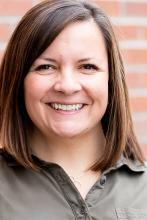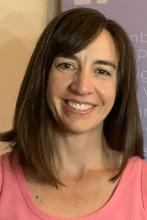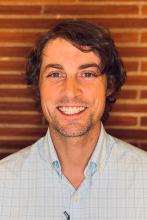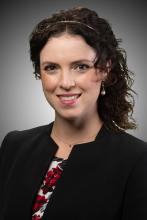A Spotlight on Adjunct Faculty for the Department of Physical Therapy
Jessica Fuentes, PT, DPT
Baylor Courses: Clinical Neuroscience, and Neuro 1
Hometown: Colorado
What attracted you to be adjunct faculty at Baylor University?
In 2018, I was invited to assist with lab when Dr. Cheryl Footer was leading the Neuro Series. She and Dr. Thomas Longbottom had assembled a team that I could not pass up. Dr. Footer had been my professor at Regis University, and I trusted that it would be an amazing opportunity. Instantly, I loved the Baylor program, and Dr. Longbottom made our team feel welcome and supported. Dr. Mike Walker was generous with his time and helped orient me to the mission of the Baylor DPT program. From the first lab immersion I knew I would grow as a PT and instructor, working in the DPT program along such accomplished educators and PTs.
Beyond teaching, what is your focus within the physical therapy profession?
In addition to teaching, I have a passion for the practice of pediatric physical therapy. I have owned a private practice outside of Boulder, Colorado for more than 15 years. I am committed to serving children and families. I also believe that therapists are at their best when providing care that is evidence-based and in collaboration with families. I enjoy learning about how empathy and family-centered care can transform the therapeutic alliance.
Why did you desire to become a physical therapist?
I knew I wanted to be a PT from a very young age. Growing up, my dad was an avid Denver Broncos fan and was a public relations professional in Denver, so he was invited to attend events and I would tag along. One pivotal outing was to the Broncos training facility–I loved the energy and the positivity of the training staff. At about the same time, I started to volunteer at my elementary school helping the students with special needs get their lunches, get to and from class, etc. Throughout middle school and high school I sought out ways to work with both athletes and with children facing challenges. In college, I finally learned about pediatric PT while completing service hours required by Gonzaga University for graduation. It felt like the combination I had been searching for. I knew from that moment I would work my hardest to become a pediatric PT.
What sets the Baylor DPT program apart from others?
From my perspective, the care taken for both adjunct faculty and students alike has been remarkable. As an adjunct faculty member, I felt right at home on the neuro team from our first lab together. As a clinical instructor, I was also so encouraged to hear that the students felt heard, and respected during their time at Baylor DPT. I think the ongoing relationships that students have with faculty speaks to how connected the program is–despite its hybrid nature, or perhaps because of its hybrid nature.
Teresa S. Gingles, PT, DPT
Baylor Courses: Mgmt of the Aging Adult, Physical Therapy Examination, and Mgmt of the Complex Patient
Hometown: Waco, Texas
What attracted you to be adjunct faculty at Baylor University?
After being a full-time clinician for more than 10 years and getting my Board Certification in Geriatrics, I found myself wanting to share my passion and experiences for treating older adults with the next generation of PTs. I knew it was time to step outside of my own comfort zone to lead and share more of my energy and approach to treating patients and connecting with people.
Beyond teaching, what is your focus within the physical therapy profession?
I currently treat patients in the outpatient orthopedic setting for Baylor Scott and White, and thoroughly enjoy connecting with people, especially older adults, to reach their goals and improve their trajectory. Apart from the calling to be a PT and teach, I have recently, again, been called out of the boat to start a nonprofit organization here in Waco, Texas called BETTER AT LAST. Being a PT and teaching has prepared me for this. Our mission is to empower and encourage older adults to live with purpose throughout their lives by better connecting them to their strength and wellness, their community, and their future. We want more people to take a proactive approach towards aging well, find purpose and connections after retirement, and change their culture of aging so that we can change THE culture of aging. We want to keep older adults thriving, active, and participating because that not only improves their lives, but improves all our lives and our community.
Why did you desire to become a physical therapist?
My worlds of activity, exercise, and helping others all collided one day when I visited an inpatient rehab facility in central Louisiana, working for a neuro psychologist. I realized that I could cheer people on and make a lasting impact in preventing pain and suffering, recovering from illness and injury, and improving the quality of life of people, and I really love people.
What sets the Baylor DPT program apart from others?
I am continuously impressed by the diversity and caliber of faculty Baylor’s DPT program is able to recruit due to the hybrid model. I am surrounded by some of the best and brightest from all over the country who come to Waco throughout the year to pour into our students from wherever they live. It’s incredible to me to walk into our labs and be “star struck” by our own faculty. They are major contributors to national PT conversation, and I am constantly learning from all of them.
Nicholas Moore, PT, DPT, OCS, FAAOMPT
Baylor Courses: PT Examination, MSK System I, MSK System II, and Advanced Patient Management
Hometown: Sterling, Colorado
What attracted you to be adjunct faculty at Baylor University?
During the process of fellowship training, I have the opportunity to meet and work with a huge number of the highest quality, compassionate, motived therapists I had ever met. Having grown up in Texas, the reputation of Baylor as an institution has always been of the highest caliber. So, when one gets the opportunity to work with these kinds of folks at that kind of institution, it's hard to turn it down.
Beyond teaching, what is your focus within the physical therapy profession?
To begin, I had several older PTs and wonderful clinical instructors who put time into my development, and I see the need to pass it on as well. I have always loved clinical practice and teaching within the clinic. It is wonderful to see students grow in skill and comfort with their knowledge as well as facilitate that development as best I can. Further, I believe it to an important piece of my own continued development as a clinician as I am constantly challenged to think about why I am doing what I am doing. Why you do what you do in the clinic is the beginning of what you do in the clinic.
Additionally, and I am the co-owner of a small private practice in Sterling, Colorado which opened two years ago. It is a mixed-pay clinic which also provides pelvic floor, persistent pain, and wellness and performance-oriented services to our community.
Why did you desire to become a physical therapist?
My story is pretty typical. I was injured as a preteen and had a few knee surgeries in high school. I continued to battle bilateral knee pain for the better part of fifteen years and during the fairly prolonged rehabs I really got to know the therapists who worked with me really well. In the end, it really was the mixture of intellectual fulfillment and interpersonal relationships that solidified it as an option. I love helping others and building relationships that continue outside of the clinic.
As PTs we get the opportunity to spend more time with patients/clients than almost any other providers. What a unique opportunity we have to learn from and enjoy others! Additionally, the human condition provides a much more complex puzzle than a mere mixture of muscle, bone, and nervous tissue. I love the whole of it!
What sets the Baylor DPT program apart from others?
I have never seen a program which is so given to the holistic care of its students. Graduate school is and should be much harder than undergraduate training. Match that with a 2-year hybrid program and it’s a high point of stress for many students. I have continually been impressed by the compassion, time, tears, and resources this faculty put in year after year in order to facilitate student’s success. I know this is not true for all programs. I think that, like when you become a parent and become aware of all your parents did for you, coming on as an adjunct has given me a greater appreciation for Baylor’s commitment to their student’s well-being.
In addition to being a PT, I am a bi-vocational minister and would be remiss in not speaking to this. Needless to say, the navigation and integration of faith within Academia is challenging at best. I have appreciated the program’s struggling through tough issues and their respect for differences when bringing not only faculty but students from many walks of life and striving for harmony in a graduate learning environment. We can disagree vehemently on very important issues and love all the more strongly because we all are made in the image of God. This is Christian graciousness which ought to demarcate those of the faith.
Katherine Schweitzer, DPT
Baylor Courses: PTE, and MSKs
Hometown: Schertz, Texas
What attracted you to be adjunct faculty at Baylor University?
At Baylor, I had the honor of teaching and learning how to instruct from my Physical Therapy heroes. I was honored to be considered as adjunct faculty. These were the PTs whose research I read about, incorporated in my didactic training in PT school, and then saw again in my residency.
What is your focus within the physical therapy profession?
My focus is to create a safe place for patients, students, and colleagues to have a platform to be vulnerable, share wins, share hopes, and everything in between in order to participate and realize their full potential.
Why did you desire to become a physical therapist?
This was a narrow win between my desire to be an educator. Now I get to do both! As an athlete, I had poor physical therapy experiences so I was interested in doing “more” for my patients.
What sets the Baylor DPT program apart from others?
The faculty, the student caliber, and the culture of leadership and service of the university.




